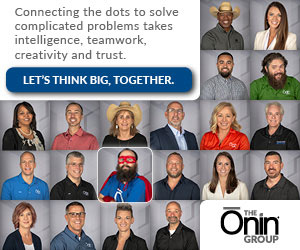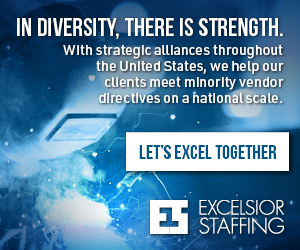Technological advancements are increasing the manufacturing skills gap. According to a Deloitte report, 65% of survey respondents said attracting and retaining talent was their primary business challenge.
Bridging the manufacturing skills gap is a growing concern as the labor market becomes more competitive. Addressing this gap requires proactive strategies for staffing success.
Growing Need for Skilled Manufacturing Labor
Many factors elevate the need for skilled manufacturing labor:
- Retiring employees: Experienced employees leaving the workforce create a need for qualified replacements. Otherwise, the Deloitte report estimates 1.9 million manufacturing jobs could go unfilled.
- Advanced technologies: According to Deloitte, technological investment creates the need to fill up to 3.8 million manufacturing jobs between 2024 and 2033. Internet of Things (IoT)-enabled systems, artificial intelligence (AI)-powered machinery, automation, and robotics require employees skilled in programming, machine operation, and data analysis to operate, maintain, troubleshoot, and resolve issues.
- Shift toward customization: Consumers demand high-quality, customized products, requiring employees skilled in precision machining, advanced assembly techniques, and quality control.
Impact of the Manufacturing Skills Gap
A lack of candidates’ skills and capabilities matching manufacturers’ needs impacts firms in these ways:
- Lower productivity rates: Having only a few qualified employees working on a project extends the timelines for completion.
- Reduced quality outputs: Assigning less-qualified employees to projects can result in lower-quality products.
- Decreased revenue: Extended production timelines, lower output, and reduced-quality products impact profits and the company’s reputation.
The following strategies help bridge the manufacturing skills gap for staffing success.
Reframe Perceptions of Manufacturing Careers
Clarify how manufacturing jobs are safe, engaging, stable, and rewarding:
- Emphasize job opportunities working with emerging technologies.
- Demonstrate continuous learning and growth opportunities.
- Show the importance of technological sophistication, intellectual stimulation, and innovation for long-term professional success.
Partner with Educational Institutions
Create partnerships with area technical schools, community colleges, and universities to customize manufacturing training and attract talent:
- Develop apprenticeships for tailored, hands-on learning.
- Provide opportunities to learn advanced tools and technologies, such as AI, IoT, automation, robotics, and smart manufacturing.
- Offer certification for enhanced knowledge and skill development.
- Support career paths without a traditional degree.
Prioritize Diversity, Equity, and Inclusion
Diversity recognizes and values employee differences in race, gender, age, ethnicity, and other personal characteristics. Equity ensures that employees have tailored resources, guidance, and support for professional advancement. Inclusion creates an environment where everyone feels valued, heard, and appreciated.
Importance of diversity, equity, and inclusion
Diversity, equity, and inclusion (DEI) in manufacturing increase efficiency and innovation:
- Employees who feel valued and respected remain motivated, engaged, and committed.
- Engaged employees elevate productivity, performance, and accuracy.
- Different experiences, perspectives, and problem-solving approaches strengthen creativity and problem-solving.
- Challenging conventional thinking leads to groundbreaking solutions in product design, supply chain management, and decision-making.
Tips for fostering diversity, equity, and inclusion
These tips foster DEI in manufacturing:
- Implement inclusive policies: Prioritize inclusivity at every organizational level through clear, actionable, regularly reviewed policies that align with workforce needs.
- Update your hiring strategy: Revise your job descriptions to use gender-neutral language and diversify the applicant pool. Use AI-powered tools to review resumes. Focus on skills, experience, and accomplishments rather than personally identifying characteristics to shortlist candidates.
- Offer mentorship: Pair seasoned employees with new hires to support a smooth organizational integration and a path for continuous learning and growth.
- Provide DEI training: Regular DEI training sessions help employees recognize unconscious biases, understand the nuances of microaggressions, and appreciate diversity in the workplace.
- Emphasize open communication: Share communication channels for employees to ask questions, voice concerns, and provide constructive feedback. Examples include regular town hall meetings, anonymous suggestion boxes, and dedicated committees.
Request Employee Referrals
Encourage manufacturing employees to refer members of their networks to fill job openings:
- Employee referrals typically have the required skills, fit the company culture, and remain long-term.
- Referrals can be fast-tracked through the hiring process, onboarded, and trained to begin producing.
- Incentivizing employees for successful referrals costs less than sourcing qualified candidates.
These tips support employee referrals:
- Share job openings: Provide a list of vacancies and job descriptions.
- Include an incentive: Offer an employee bonus for successful referrals.
- Provide feedback: Clarify why a referral’s skills and experience did or did not help them secure employment.
Provide Upskilling and Reskilling Opportunities
Upskilling supports employee skill enhancement to enhance job performance. In contrast, reskilling equips employees to fill other roles.
Upskilling and reskilling opportunities enhance employees’ organizational value. Manufacturing employees who are proficient with modern systems are positioned for career advancement.
Investing in continuous learning programs, such as digital learning platforms, virtual reality (VR), or augmented reality (AR), provides flexible and interactive training opportunities. Manufacturing employees can engage in hands-on training without disrupting business operations.
Encourage Continuous Learning
These strategies encourage regular skill development in manufacturing employees:
- Prioritize onboarding: Create a foundation for ongoing learning and skill enhancement.
- Facilitate knowledge transfer: Encourage peer-to-peer learning for knowledge and skill acquisition.
- Offer career development paths: Clear career trajectories and training plans show commitment to employee growth and retention.
Work with Manufacturing Staffing Firms
Manufacturing staffing firms help bridge skills gaps in these ways:
- Implementing an organization-wide skills assessment: Identifying the current and required skills within a client’s workforce.
- Creating targeted placement strategies: Developing strategic plans for a client to hire, onboard, train, and retain skilled employees.
- Offering flexible staffing solutions: Providing temporary, temp-to-hire, or direct-hire placements to fill unique hiring needs.
- Navigating workforce fluctuations: Offering on-demand staffing for temporary or permanent placements as needed.
- Providing vetted candidates: Connecting clients with a network of screened, qualified candidates.
- Accessing specialized skills: Finding candidates with niche skills that a client needs for additional projects and revenue.
- Evaluating cultural fit: Ensuring skilled candidates align with a client company’s mission, vision, and values for long-term success.
- Implementing training programs: Offering clients tailored guidance and support for employee training opportunities.
- Maintaining compliance: Complying with current laws and regulations.
- Reducing time-to-hire: Interviewing a few vetted candidates saves clients time in the hiring process.
- Minimizing bad hires: Requesting a replacement at no additional cost if a placement is not a good fit.
- Lowering staffing costs: Minimizing client expenses relevant to candidate sourcing, screening, and interviewing.
- Supporting business growth: Bridging skills gaps strengthens a client company’s operational continuity, efficiency, and expansion.
Partner with Ōnin Staffing
What if a staffing partner did more than just place people in your facility and hope for the best? Ōnin does. From hiring and onboarding to long-term retention, we help you build a stronger, more reliable workforce.
Sources:
- https://www.vectorsolutions.com/resources/blogs/closing-the-manufacturing-skills-gap-essential-strategies/#:~:text=Strategic%20Approaches%20to%20Closing%20the,stemming%20from%20systemic%20process%20inefficiencies.
- https://blogs.sw.siemens.com/thought-leadership/2024/10/11/bridging-the-skills-gap-in-manufacturing-through-reskilling-upskilling-and-educating/
- https://thexcelgroup.com/the-rise-of-skilled-labor-in-light-industrial-manufacturing/#:~:text=The%20Role%20of%20Staffing%20Agencies,retention%20through%20targeted%20placement%20strategies
- https://www2.deloitte.com/us/en/pages/about-deloitte/articles/press-releases/us-manufacturing-could-need-new-employees-by-2033.html
- https://diversio.com/industries/dei-manufacturing/
- https://www.alliedonesource.com/the-role-of-staffing-agencies-in-bridging-the-skills-gap#:~:text=Time%2DEfficient%20Recruitment&text=This%20means%20time%20is%20of,time%2Defficient%20and%20successful%20hiring.
- https://www.indeed.com/career-advice/career-development/employee-referrals#:~:text=What%20are%20employee%20referrals?,network%20to%20refer%20qualified%20candidates.






